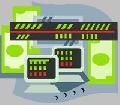
 |
|
| Financial Terms | |
| Low price |
|
Information about financial, finance, business, accounting, payroll, inventory, investment, money, inventory control, stock trading, financial advisor, tax advisor, credit.
Main Page: finance, accounting, credit, tax advisor, inventory control, inventory, stock trading, payroll, |
Definition of Low price
Low priceThis is the day's lowest price of a security that has changed hands between a buyer and a seller.
Related Terms:Low price-earnings ratio effectThe tendency of portfolios of stocks with a low price-earnings ratio to Price-specie-flow mechanismAdjustment mechanism under the classical gold standard whereby Attribute biasThe tendency of stocks preferred by the dividend discount model to share certain equity Closing rangeAlso known as the range. The high and low prices, or bids and offers, recorded during the RangeThe high and low prices, or high and low bids and offers recorded during a specified time. Trading rangeThe difference between the high and low prices traded during a period of time; Value managerA manager who seeks to buy stocks that are at a discount to their "fair value" and sell them at  NPV (net present value of cash flows)Same as PV, but usually includes a subtraction for an initial cash outlay. PV (present value of cash flows)the value in today’s dollars of cash flows that occur in different time periods. Arm's length priceThe price at which a willing buyer and a willing unrelated seller would freely agree to Ask priceA dealer's price to sell a security; also called the offer price. Bargain-purchase-price optionGives the lessee the option to purchase the asset at a price below fair market Basis priceprice expressed in terms of yield to maturity or annual rate of return. Bid priceThis is the quoted bid, or the highest price an investor is willing to pay to buy a security. Practically Blow-off topA steep and rapid increase in price followed by a steep and rapid drop. This is an indicator seen Call priceThe price, specified at issuance, at which the issuer of a bond may retire part of the bond at a  Call priceThe price for which a bond can be repaid before maturity under a call provision. Cash flowIn investments, it represents earnings before depreciation , amortization and non-cash charges. Cash flow after interest and taxesNet income plus depreciation. Cash flow coverage ratioThe number of times that financial obligations (for interest, principal payments, Cash flow from operationsA firm's net cash inflow resulting directly from its regular operations Cash flow matchingAlso called dedicating a portfolio, this is an alternative to multiperiod immunization in Cash flow per common shareCash flow from operations minus preferred stock dividends, divided by the Cash flow time-lineLine depicting the operating activities and cash flows for a firm over a particular period. Cash-flow break-even pointThe point below which the firm will need either to obtain additional financing Clean priceBond price excluding accrued interest. Consumer Price Index (CPI)The CPI, as it is called, measures the prices of consumer goods and services and is a Conversion parity priceRelated:Market conversion price Convertible priceThe contractually specified price per share at which a convertible security can be Delivery priceThe price fixed by the Clearing house at which deliveries on futures are in invoiced; also the Devaluation A decrease in the spot price of the currency
Dirty priceBond price including accrued interest, i.e., the price paid by the bond buyer. Discounted cash flow (DCF)Future cash flows multiplied by discount factors to obtain present values. Discretionary cash flowCash flow that is available after the funding of all positive NPV capital investment Dollar price of a bondPercentage of face value at which a bond is quoted. Effective call priceThe strike price in an optional redemption provision plus the accrued interest to the Equilibrium market price of riskThe slope of the capital market line (CML). Since the CML represents the Equivalent annual cash flowAnnuity with the same net present value as the company's proposed investment. Exercise priceThe price at which the underlying future or options contract may be bought or sold. Expected future cash flowsProjected future cash flows associated with an asset of decision. Fair market priceAmount at which an asset would change hands between two parties, both having Fair priceThe equilibrium price for futures contracts. Also called the theoretical futures price, which equals Fair price provisionSee:appraisal rights. Fixed price basisAn offering of securities at a fixed price. Fixed-price tender offerA one-time offer to purchase a stated number of shares at a stated fixed price, Flat price riskTaking a position either long or short that does not involve spreading. Flat price (also clean price)The quoted newspaper price of a bond that does not include accrued interest. Flower bondGovernment bonds that are acceptable at par in payment of federal estate taxes when owned by Flow-through basisAn account for the investment credit to show all income statement benefits of the credit Flow-through methodThe practice of reporting to shareholders using straight-line depreciation and Free cash flowsCash not required for operations or for reinvestment. Often defined as earnings before Full priceAlso called dirty price, the price of a bond including accrued interest. Related: flat price. Futures priceThe price at which the parties to a futures contract agree to transact on the settlement date. High priceThe highest (intraday) price of a stock over the past 52 weeks, adjusted for any stock splits. Incremental cash flowsDifference between the firm's cash flows with and without a project. Invoice priceThe price that the buyer of a futures contract must pay the seller when a Treasury Bond is delivered. Law of one priceAn economic rule stating that a given security must have the same price regardless of the Limit priceMaximum price fluctuation Low-coupon bond refundingRefunding of a low coupon bond with a new, higher coupon bond. Limit priceMaximum price fluctuation Market conversion priceAlso called conversion parity price, the price that an investor effectively pays for Market price of riskA measure of the extra return, or risk premium, that investors demand to bear risk. The Market pricesThe amount of money that a willing buyer pays to acquire something from a willing seller, Marketplace price efficiencyThe degree to which the prices of assets reflect the available marketplace Maximum price fluctuationThe maximum amount the contract price can change, up or down, during one Minimum price fluctuationSmallest increment of price movement possible in trading a given contract. Also Nominal cash flowA cash flow expressed in nominal terms if the actual dollars to be received or paid out are given. Nominal priceprice quotations on futures for a period in which no actual trading took place. Opening priceThe range of prices at which the first bids and offers were made or first transactions were Operating cash flowEarnings before depreciation minus taxes. It measures the cash generated from Option priceAlso called the option premium, the price paid by the buyer of the options contract for the right Plowback rateRelated: retention rate. Price/book ratioCompares a stock's market value to the value of total assets less total liabilities (book Price/earnings ratio (PE ratio)Shows the "multiple" of earnings at which a stock sells. Determined by dividing current Price/sales ratio (PS Ratio)Determined by dividing current stock price by revenue per share (adjusted for stock splits). Price compressionThe limitation of the price appreciation potential for a callable bond in a declining interest Price discovery processThe process of determining the prices of the assets in the marketplace through the Price elasticitiesThe percentage change in the quantity divided by the percentage change in the price. Price impact costsRelated: market impact costs Price momentumRelated: Relative strength Price persistenceRelated: Relative strength Price riskThe risk that the value of a security (or a portfolio) will decline in the future. Or, a type of Price takersIndividuals who respond to rates and prices by acting as though they have no influence on them. Priced outThe market has already incorporated information, such as a low dividend, into the price of a stock. Price value of a basis point (PVBP)Also called the dollar value of a basis point, a measure of the change in Pricesprice of a share of common stock on the date shown. Highs and lows are based on the highest and Price-volume relationshipA relationship espoused by some technical analysts that signals continuing rises Production-flow commitmentAn agreement by the loan purchaser to allow the monthly loan quota to be Put priceThe price at which the asset will be sold if a put option is exercised. Also called the strike or Real cash flowA cash flow is expressed in real terms if the current, or date 0, purchasing power of the cash Reverse price riskA type of mortgage-pipeline risk that occurs when a lender commits to sell loans to an Scheduled cash flowsThe mortgage principal and interest payments due to be paid under the terms of the Settlement priceA figure determined by the closing range which is used to calculate gains and losses in Spot priceThe current marketprice of the actual physical commodity. Also called cash price. Stated conversion priceAt the time of issuance of a convertible security, the price the issuer effectively Statement of cash flowsA financial statement showing a firm's cash receipts and cash payments during a Statement-of-cash-flows methodA method of cash budgeting that is organized along the lines of the statement of cash flows. Strike priceThe stated price per share for which underlying stock may be purchased (in the case of a call) or Subscription priceprice that the existing shareholders are allowed to pay for a share of stock in a rights offering. Related to : financial, finance, business, accounting, payroll, inventory, investment, money, inventory control, stock trading, financial advisor, tax advisor, credit. |